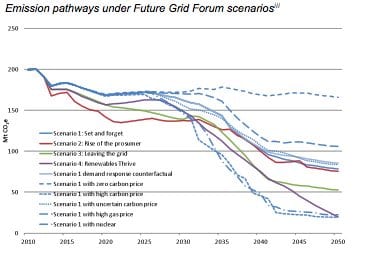It’s rare to find agreement on anything regarding electricity policy in Australia. So when a group like the Future Grid Forum agrees that the electricity sector is in dire need of a strong, stable, long-term carbon policy, it’s worth taking note.
The group represents power generators, consumer groups, regulators, researchers, providers of energy hardware, economists, environmental NGOS, transmission and distribution businesses, and large energy users. Convened by CSIRO to explore the future of electricity in Australia, their new report Change and Choice calls for “bipartisan agreement on the long-term (2050) greenhouse gas emission target and implementation mechanism for Australia”, to prevent inefficient investment and higher electricity costs.
The Forum investigated the long-term implications of issues like the clean tech revolution, changes in demand, the role of electric vehicles, the impacts of high gas prices, climate change and emissions reduction. It found that uncertain carbon policy adds an extra 17 per cent to the costs of electricity, while rising temperatures could see households paying an extra $180 a year.
Below is a figure showing the emissions reduction resulting from the Forum’s scenarios. All four core scenarios include a carbon price incentive and one (‘Renewables Thrive’) also includes a 100 per cent Renewable Energy Target (RET). Because of this, emissions are reduced across all four scenarios, achieving cuts of 55-89 per cent below 2000 levels by 2050.
The Forum also looked at the impact of a high carbon price incentive, based on Treasury’s modelling of a cost to carbon pollution consistent with global action to limit global temperature rise to two degrees or less; a ‘zero carbon price’, which assumes that Australia will never have carbon policy apart from the current RET, which peaks in 2020; and an uncertain carbon policy scenario, where investors can never be certain that a carbon policy will or will not be applied in the future – an extension of the current lack of bipartisan support for climate policy.
Unsurprisingly, under ‘zero carbon price’ emissions stop falling after 2020. In contrast, the high carbon price incentive achieves emissions reductions greater even than the 100 per cent RET.
 Emission pathways under Future Grid Forum scenarios
Emission pathways under Future Grid Forum scenarios
Interestingly, even uncertain carbon policy we see fairly substantial emissions reduction. However, as the next figure shows, the uncertain carbon price scenario is 17 per cent more expensive than the core ‘Set and Forget’ scenario on which it is based. In fact, the uncertain carbon price is not much cheaper than the high carbon price ($145 per megawatt hour compared with $160), but achieves far less emission reduction (about 50 per cent below 2000 levels compared with 89 per cent).
This is because under carbon policy uncertainty investors hedge against the risk of future policy changes by investing in generation that remains competitive under different carbon policy environments. This tends to be plant that is cheaper to build but less efficient to run. The extra costs of this inefficiency are passed on to customers through higher bills.
Without any policy to reduce emissions, coal plays a renewed role from 2020. This ‘zero carbon price’ scenario appears to be the cheapest in terms of pure electricity costs because it pushes the costs of carbon reduction on to others. This scenario implies that other sectors do the heavy lifting to reduce Australia’s emissions, or that Australia maintains its current emission-intensive economy, relying entirely on other countries’ willingness to cover Australia’s share of the task
If electricity emissions are not reduced, finding equivalent carbon reductions elsewhere in the economy would be so expensive and difficult it would be effectively impossible for Australia to make its fair contribution to addressing climate change. In the absence of international emissions trading, even the largest reductions modelled by CSIRO would not be sufficient for Australia to do its part in keeping global warming to less than 2°C.
Climate change itself holds significant risks for the electricity sector. The Forum examined the role of increasing temperatures in driving up peaks in consumption (i.e. for cooling purposes). This single impact increases network costs by 2.8c per kilowatt hour (kWh). In today’s terms that translates into an extra $182/year for an average household using 6500 kWh annually. The costs of extreme weather events on electricity infrastructure would see costs increase further.
The electricity sector’s call for long term climate planning is being echoed in multilateral climate talks. These are focusing not only on strengthening countries’ pre-2020 emission reduction targets, but also on their post-2020 carbon cuts. After the Warsaw climate talks, Australia has about a year to resolve targets for both timeframes, including defining our 2025/30 emissions reduction offer.
CSIRO’s modelling for the Forum adds to the weight of evidence that we will pay the costs of climate change one way or the other, but the longer we put it off the higher they will be.
[1] Figure 121: Projected greenhouse gas emissions by scenario and sensitivity case.CSIRO and ROAM Consulting, Modelling the Future Grid Forum scenarios, CSIRO, December 2013.
[1] Figure 122: Wholesale unit cost and projected greenhouse gas abatement relative to 2000 levels by scenario (abatement and unit costs at 2013 is shown for comparison), CSIRO and ROAM Consulting, Modelling the Future Grid Forum scenarios, CSIRO, December 2013.
Olivia Kember is Policy Manager at The Climate Institute








